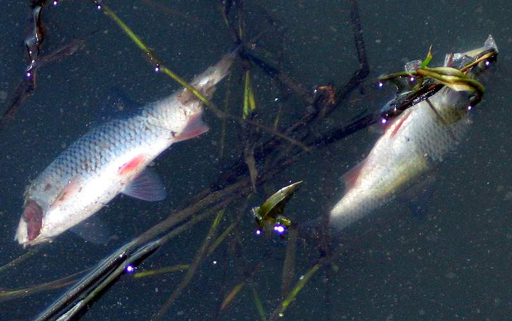8.1.1 Effects of organic pollution
You will remember from Study Session 7 that organic matter is any material derived from living organisms. Organic pollution is any contamination of water by organic matter. Examples include human and animal wastes and urban run-off.
Many aquatic (water-living) organisms depend on oxygen dissolved in the water to survive. Aquatic animals include fish, amphibians (e.g. frogs, toads) and many invertebrate species such as insect larvae, snails and worms. Their supply of oxygen in the water is maintained from atmospheric oxygen in the air above the water and from oxygen produced by green aquatic plants in the process of photosynthesis. Fast-flowing, turbulent water will be aerated (gain oxygen) more than still water because the boundary between air and water is more active.
If organic pollutants such as human and animal wastes are released into a water body, bacteria will use the waste as food. Bacteria break down the complex organic chemicals (proteins, fats, carbohydrates) into simpler chemicals that are further oxidised into nitrates, sulphates and carbonates. This process, known as biodegradation, provides energy to the bacteria and uses dissolved oxygen from the water.
If the quantity of organic matter is small and there is plenty of dissolved oxygen, then this natural breakdown process will remove the pollution quite quickly. However, if there are high levels of organic pollution, the population of bacteria increases and may use up all the oxygen from the water. This is called deoxygenation. Complete deoxygenation is unlikely in a river where the water is moving, but it can happen in lakes or slow-flowing channels. Anaerobic (without oxygen) conditions are unsightly and cause unpleasant odours. Fish and other aquatic organisms that need oxygen to survive will eventually die if they cannot migrate elsewhere (Figure 8.1). The reduction in fish populations and other aquatic animals not only disrupts the ecosystem but also results in a loss of food for local people and loss of jobs for local fishermen.

8.1 Effects of water pollution on the environment
